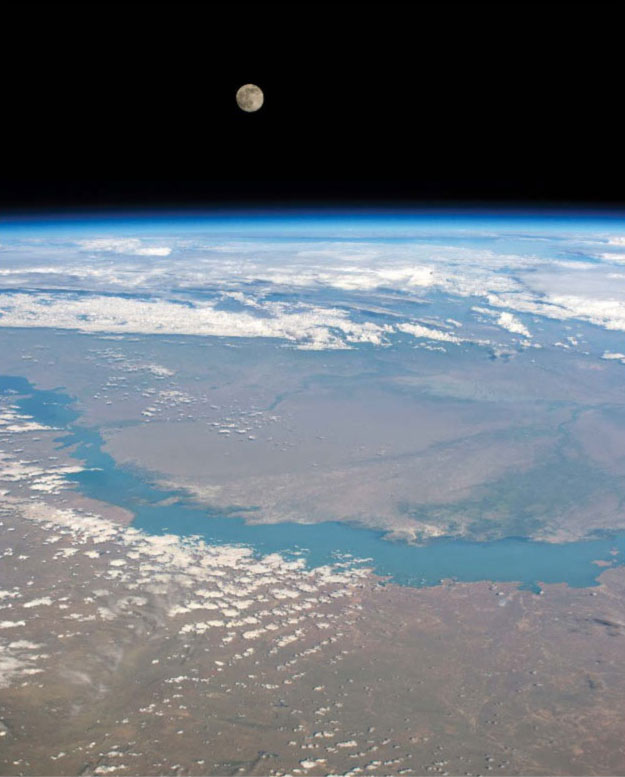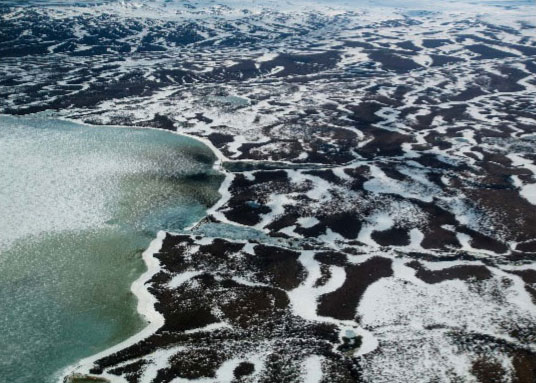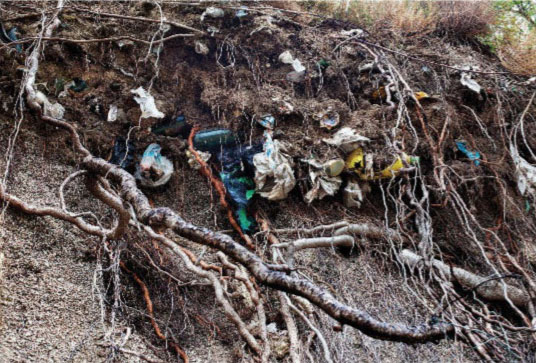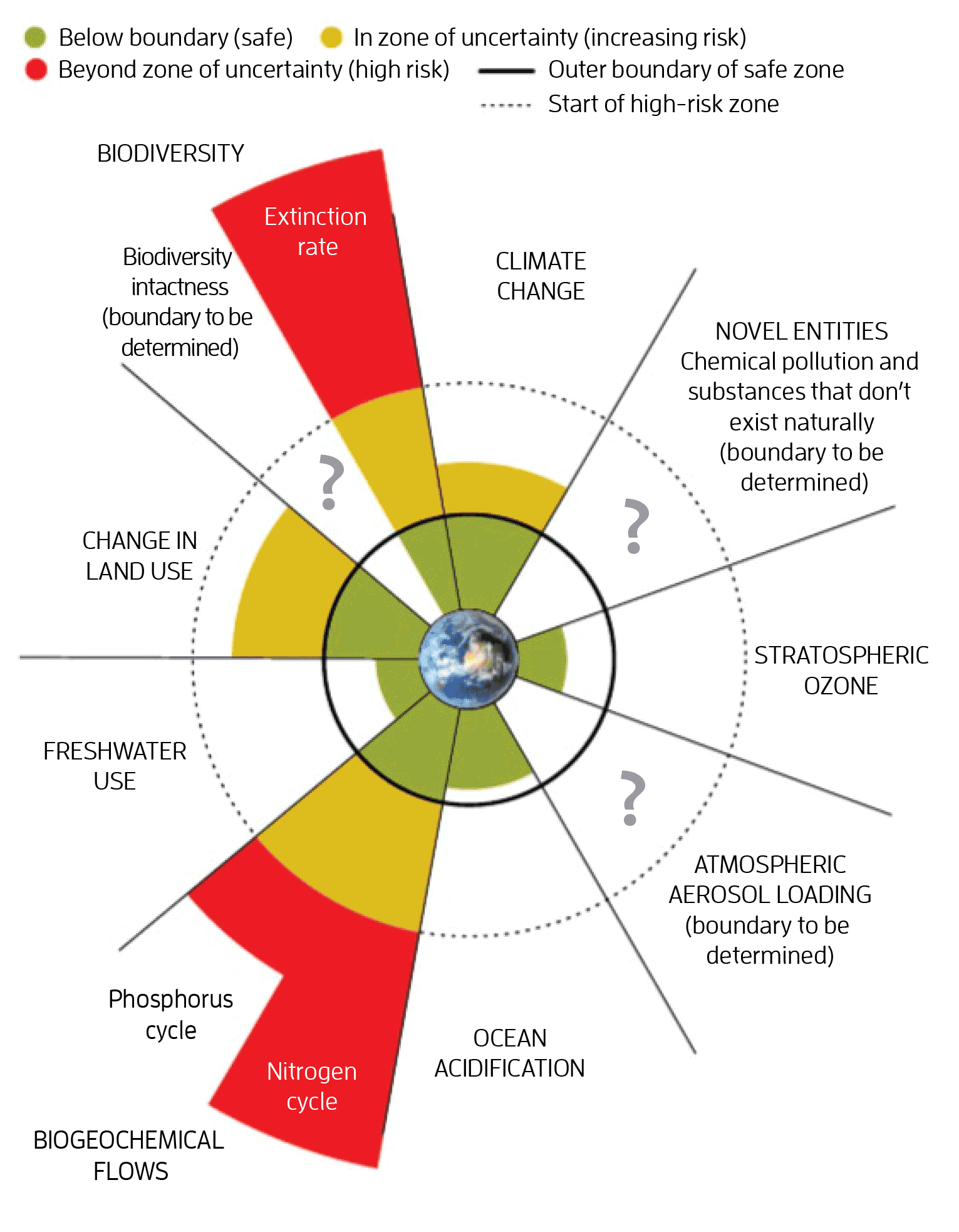New Scientist - “The changes could be abrupt and irreversible”
Fred Pearce
14 September 2019
Humanity’s life support system, as seen from space.
Straining the limits: Arctic sea ice is melting at an unprecedented rate (above), and plastic pollution is piling up (below).
Overstepping the mark
We have already gone beyond four of the nine proposed safe operating levels for humans on Earth, know as planetary boundaries.
“The changes could be abrupt and irreversible. We don’t know where things may end up”
Ten years ago, Johan Rockström identified nine limits for Earth’s life-support systems. We have already exceeded four of them, but he is still cautiously optimistic for our future, he tells Fred Pearce.
Humanity can only thrive if our planet is hospitable to us, but what are the limits to its stability? That was the question posed by Johan Rockström in 2009 in the first scientific assessment of the limits to safe living for humans on Earth. He and 28 co-authors called them the planetary boundaries. They warned that if we exceed any of those nine boundaries, we risk destabilising Earth’s life-support systems and plunging the planet into chaos. The good news, they said, is that staying inside them provided a “safe operating space” for humanity. The bad news is that we have already exceeded four of them.
The boundaries have drawn plenty of criticism, so does Rockström still stand by the findings? Is he more or less pessimistic about where we are headed? And where do Harley-Davidsons fit in?
- Fred Pearce — What is the bottom line for Earth and human civilisation?
- Johan Rockström — For the past 10,000 years, our planet has been in a uniquely stable state, a warm interglacial era with largely unchanging climate and ecosystems that we call the Holocene. It is the era during which human civilisation has developed, from huntergatherers to digital technology. It is all we know.
But humanity is now driving changes like global warming and species extinctions. These threaten to push us beyond the thresholds of the life-support systems that have sustained the Holocene.
The changes could be abrupt and irreversible. We don’t know where things may end up. If the Holocene is our desired reference point – the stable planet we know and depend on – we need to find out where those thresholds are, thus identifying our safe operating space. That is what our research on planetary boundaries tries to do.
- So what are these boundaries?
- We identify nine. There are three that operate at a planetary scale: the oceans, the atmospheric climate system and the stratospheric ozone layer. Each has thresholds beyond which danger lies. There are four more that we call biosphere boundaries. They help regulate the planetary systems. They are biological diversity, the hydrological cycle, land cover such as forests, and the flows of nutrients vital to life, such as nitrogen and phosphorus
Finally, we identify two categories of alien things that don’t exist naturally: novel entities including nuclear waste and gender-bending chemicals, and aerosol air pollution, which alters Earth’s energy balance and impacts regional climate systems such as the south Asian monsoon.
- How do we know when we have crossed a planetary boundary?
- Our scientific understanding of Earth systems has advanced tremendously over the past 30 years, but still we don’t know exactly where the critical boundaries are for these systems. So we apply a precautionary approach. We identify safe zones and high-risk zones. Between them, uncertainty ranges, within which we don’t know what might happen. We place the planetary boundary at the lower levels of the uncertainty ranges.
- What is the boundary for climate change, for example?
- For climate change, we chose the atmospheric concentration of the most important greenhouse gas, carbon dioxide. We assessed the uncertainty range as being between 350 and 450 parts per million, so the planetary boundary is 350 ppm.
The world is now well above that, at 410 ppm, and we are starting to see dangerous impacts. In the oceans, there is heating, a slowing down of the Gulf Stream and accelerated Arctic seaice melting. In the atmosphere, we see a serious impact on the jet stream and many more extreme weather events. All these effects may foreshadow the breakdown of other systems, such as the hydrological cycle and biodiversity. We are already into the high-risk zones for biodiversity and nutrients.
- Your critics say you don’t properly distinguish between global and local systems.
- Of course, before you reach any of our planetary boundaries, you can have massive problems locally. Lakes dry up, rivers fill with pollution, ecosystems collapse and so on. But when we talk about keeping within a safe operating space, we mean safe for the planet as a whole, not for every human or every ecosystem. Even so, apparently local problems can go global, especially if they occur widely.
- Which problems have gone global in this way?
- Water seems very local, for instance, but there is a global hydrological cycle that is the bloodstream of the biosphere. Take away the rain and forests die, triggering massive releases of carbon into the atmosphere and loss of biodiversity. Or take away a major forest like the Amazon and we know rainfall declines thousands of kilometres away.
Science is still struggling to assess how much we can disrupt the hydrological cycle without crossing dangerous thresholds. So, for now, we have set a boundary where humans remove no more than a tenth of the natural run-off. It is a proxy for disruption of the hydrological system as a whole.
- What about biodiversity? Does the number of species on the planet actually matter?
- Biodiversity is essential. A living biosphere regulates the water cycle and climate, cleans the air and much more. A dead planet wouldn’t be habitable. So somewhere there must be a boundary. Our interest isn’t in the number of species itself, but in functional biodiversity. What is needed to maintain Earth’s life-support systems. Scholars are developing a biosphere integrity index to try to measure this. For now, we rely on the more established data on species extinctions.
- So how is our planet doing on this measure?
- The natural background extinction rate is up to 10 species per year, but the rate today is more than 1000 a year. We set the boundary at 10 times the background rate. I admit it is rudimentary, but I do believe a globally agreed scientific target for cutting extinctions would help policy-makers – like the “below 2 degrees” temperature target on climate change.
- Might there be other boundaries out there?
- I don’t think so. Nobody has made a convincing argument for a tenth boundary, or that we should take away any of the nine. But in our review next year, we are likely to add plastics to the novel entities category, and will improve some other boundaries, such as biodiversity and freshwater.
- What about a people boundary? Human population, say? After all, it is the pressure of people that is causing the problems.
- Yes, but the boundaries describe Earth’s lifesupport systems that keep us in the Holocene. The systems themselves aren’t defined by human activity. But of course, within that, our interest as humans is in how we should use the safe operating space that we identify. How to stay within it and share it fairly.
The international community has made some progress on this. There is the Paris climate agreement. And the UN’s Sustainable Development Goals explicitly recognise four boundaries within which we have to reach goals. Water, biodiversity, oceans and climate.
- In the past 10 years, have you become more or less optimistic?
- Well, the trend lines on the state of the planet make me more pessimistic. We are running out of time. We need to bend the curves within the next few years. For climate, we have to cut emissions by half over the next 10 years, or we will be well into the high-risk zone.
Still, there are some reasons for optimism. Over the past 10 years, we have seen an exponential rise in sustainable energy solutions, with solar photovoltaics, wind power and electric mobility all much more economically competitive. And there is cultural buy-in. Harley-Davidson just announced it is going electric. For me, that is hugely symbolic.
- So could we be at a positive tipping point in humanity’s response to these threats?
- I very much hope so. Change is happening. We may be entering a new era, a renaissance in which sustainability is essential to the success of businesses.
The question now is whether the change is happening fast enough to keep us within the safe operating space. And we don’t know the answer to that yet. ❚
Fred Pearce is a New Scientist consultant and the author of When the Rivers Run Dry: The global water crisis and how to solve it.





